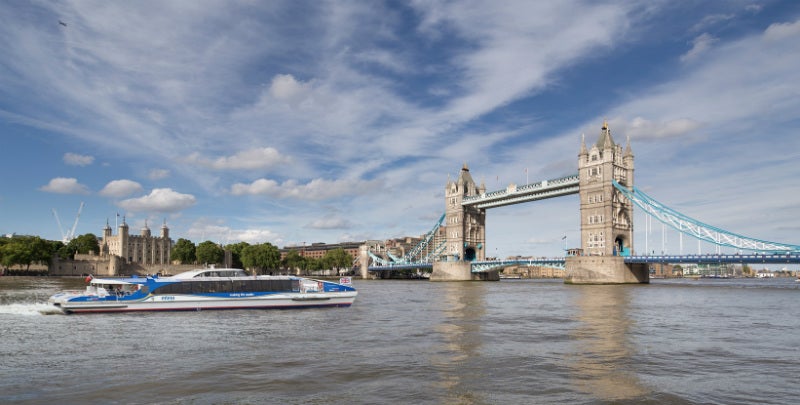
No picturesque London postcard is complete without the river Thames – the 95-mile long waterway that passes through the nation’s capital and to the North Sea beyond. And over the last two decades, the super-sleek river buses that trundle stoically up and down the river have become an increasingly welcome sight for tourists and commuters.
Since coming into being in 1999, the MBNA Thames Clippers service has moved from a one-boat service to a hardy squadron of 17 catamarans, charting a course from Putney in south-west London to Royal Arsenal Woolwich in the east. Every 20 minutes, a boat sets down at various piers spanning a number of London hotspots, including Greenwich, Canary Wharf, Tower Hill, London Bridge, Westminster and Waterloo.
Recently, the Clippers announced a major milestone: more than 40 million passengers have set foot on the river-buses since the first boat set off nearly 20 years ago.
“If someone had just said to me ‘did you know you are up to your 40 millionth passenger?’ I probably would have looked a bit surprised,” says MBNA Thames Clippers CEO and co-founder Sean Collins. “But actually when it’s been worked out you can see how it’s true.”
Since its inception, Thames Clippers have proven that the river can be an asset for passenger travel, alongside its burgeoning freight successes. But what does the future hold?
Rolling on the river

How well do you really know your competitors?
Access the most comprehensive Company Profiles on the market, powered by GlobalData. Save hours of research. Gain competitive edge.

Thank you!
Your download email will arrive shortly
Not ready to buy yet? Download a free sample
We are confident about the unique quality of our Company Profiles. However, we want you to make the most beneficial decision for your business, so we offer a free sample that you can download by submitting the below form
By GlobalDataPassenger numbers have “ebbed and flowed” on the river, says Collins. However with an increase from around 30,000 annual passengers at launch, to more than four million today, an appetite has definitely developed.
Collins says that the major contributors to the upsurge has been a combination of adding new boats to the fleet, expanding routes and services and the success of both commercial and residential developments alongside the river.
Routes pass through major commercial, residential and leisure hotspots. Tourists, for example, can hop on at Westminster after a good gawk at the Houses of Parliament, and sail eastwards to gawk at Greenwich’s Royal Observatory instead. Battersea Power Station was added to the network in 2017, providing a new stop-off for residents, workers and visitors.
“We’ve had some real key attractions and developments very close to the river that have contributed to driving that footfall – and where we’ve added the capacity, and where we’ve added the routes, the footfall has come running,” says Collins.
Bringing commuters on board

Convincing commuters to come aboard has been a challenge, but Collins says that efforts to improve the riparian areas around piers and information and announcements have borne fruit. Better integration with other services run by Transport for London (TfL), which licenses the Thames Clippers, has also proven beneficial. From November 2009, MBNA Thames Clippers services began to accept Oyster pay-as-you-go and contactless payments across its services, allowing it to dispense with the complex ticketing system that was in place.
Enhancements extend to the ferries themselves. At the end of October, MBNA unveiled the name of its 18th vessel – the Catamaran Venus Clipper – set to launch in early 2019. The new boat will feature more space and 50 extra seats when compared to its immediate predecessors, the Mercury Clipper and the Jupiter Clipper.
Existing vessels in the fleet have recently had an interior retrofit, but Collins says that boats tend to not deviate too far from the arrangements of the original craft so as to provide “a consistent level of standard” across the fleet.
Thames riverboat services recently came under fire when environmental organisations claimed that more stringent emissions rules for buses and trains had not been reflected on the river. Collins says the service worked with naval architects on a sleeker hull format to reduce the power needed to operate its vessels by up to 20%.
“We can only purchase from the engine suppliers what is on the market and we are making every effort to purchase the suitable engine for our operation with the least impact,” he says.
New waves of development

In October 2019, Clipper services will begin running to the new Royal Wharf, a massive new neighbourhood on the north bank of the Thames being developed by Ballymore and Oxley. Other major housing developments to the east of central London, such as Barking Riverside, could present opportunities for expansion in the future.
“These examples demonstrate the [rate] at which housing is going to develop down the Thames corridor, and as those developments do take place, river transport is obviously going to be a major part [of that],” he says.
“Bridges are going to be a lot less frequent the nearer you get to London because of the width of the river and the size of the ships’ ply. So there is a significant difference in the future to transporting large volumes, if not into central London, onto other mass transit modes.”
Collins says that piers need to receive money to encourage outside investment from companies, or at the very least make sure they have good access channels and are being managed properly. But while private investment in piers has proven a major boon, TfL money could well be running dry.
Fickle finances
At the time of writing, the organisation is suffering a £1bn deficit, bolstered by a freeze on public transport fares introduced by current mayor Sadiq Khan. The delayed opening of Crossrail, London’s multi-billion pound railway project, will reportedly cost £200m – a further squeeze on TfL.
“Without the continued investment in piers and infrastructure, as well as signage and marketing of interchangeability with river against other modes of transport, it will suffer,” says Collins. “Both the Port of London Authority (PLA) and TfL need to recognise the importance of these factors to allow the infrastructure of such services to operate, to meet the customer needs and demands and also achieve the passenger footfall they have set as a target.”
“I think the biggest single thing that TfL can do is include the River line in the tube map – that will really demonstrate to people how the river and other forms of transport can be connected.”
MBNA Thames Clippers is one of many stakeholders participating in the PLA’s Thames Vision, which highlights key targets for the river’s future – one of which is doubling the number of river passengers by 2035. However, Collins says that there needs to be more clearly defined targets to build momentum towards this goal.
“Imagine the number of mayors between now and 2035,” he says. “There should be four yearly targets at the very least that are aligned with the mayoral terms, and that way you can measure how much support has been given to the river in every aspect, and how much the PLA and operators can support them.”
“At the end of the day the vast majority of this infrastructure – both piers and boats out to the west and out to the east – is being delivered by the private sector. There are not many other forms of transport in London having that done. So in these times of financial pinch, we should be looking at the private sector.
“London has this amazing asset and the vast majority of it is heavily underutilised,” Collins concludes. “It needs to be utilised a lot more.”







